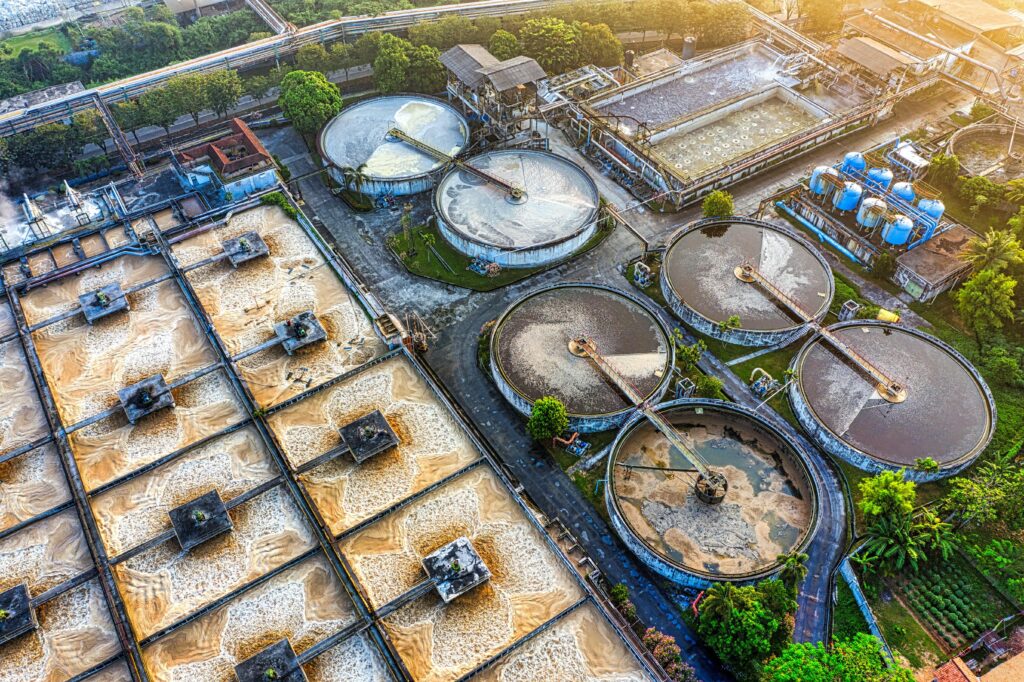Introduction to Water Management Plant
Wastewater treatment facilities play a crucial role in managing water resources by ensuring effective treatment processes to prevent pollution and manage untreated sewage discharges. From treating industrial wastewater to ensuring safe drinking water for urban populations, the sector demands innovation, and compliance with stringent regulations. This sector relies on water infrastructure companies to develop and maintain robust systems.
The article explores the cutting-edge technologies, key challenges, and top vendors driving the future of water and waste management, with insights into how BuildTwin streamlines large-scale projects.
What is Wastewater Treatment?
Wastewater treatment is a process that involves removing contaminants and pollutants from wastewater to make it safe for discharge or reuse. Wastewater treatment infrastructure employ a variety of physical, chemical, and biological processes to treat wastewater. These processes are essential components of modern water and wastewater infrastructure. These processes are typically divided into three stages: primary, secondary, and tertiary treatment.
Primary treatment involves the physical removal of large particles and debris through screening and sedimentation. Secondary treatment uses biological processes, such as activated sludge or biofilm reactors, to break down organic matter and remove dissolved pollutants. Tertiary treatment further purifies the water through advanced methods like filtration, disinfection, and nutrient removal.
The primary goal of wastewater treatment is to protect public health and the environment by eliminating harmful substances and pathogens from wastewater. By treating wastewater effectively, treatment plants help prevent waterborne diseases, protect aquatic ecosystems, and ensure the safe reuse of water for various purposes.
Wastewater Treatment Plants
Wastewater treatment plants are specialized facilities designed to treat wastewater from various sources, including households, industries, and institutions. These plants utilize a combination of physical, chemical, and biological processes to remove contaminants and pollutants from wastewater, ensuring it is safe for discharge or reuse.
There are different types of wastewater treatment plants, each serving specific needs. Municipal wastewater treatment plants handle domestic wastewater from households and institutions, focusing on removing organic matter, nutrients, and pathogens. Industrial wastewater treatment plants, on the other hand, treat wastewater generated by industrial processes, which may contain heavy metals, chemicals, and other hazardous substances. They are key to wastewater infrastructure development.
Decentralized wastewater treatment systems are smaller-scale facilities that serve individual buildings or small communities, often in remote or rural areas. These systems provide an effective solution for treating wastewater locally, reducing the burden on centralized treatment plants and minimizing the risk of environmental contamination.
The Importance of Water and Wastewater Treatment Systems
Water and wastewater systems are critical components of public health, environmental protection, and industrial efficiency. Effective water infrastructure management ensures system reliability and longevity. Key focus areas include:
- Industrial Water Waste Treatment: Safeguarding ecosystems from contaminants like heavy metals and organic pollutants.
- Municipal Sewage Systems: Managing urban wastewater to prevent health risks like sewage backups and groundwater contamination.
- Water Reuse and Recycling: Transforming wastewater into resources for agriculture, industry, or potable use.
- Stormwater Management: Mitigating urban flooding through intelligent drainage systems.
With climate change exacerbating water scarcity, the sector is projected to grow at a CAGR of 6.5%, reaching $956 billion by 2030 (Global Water Intelligence).
Key Challenges in the Industry
- Aging Infrastructure: Many municipal sewer systems, built over 50 years ago, suffer from cracks, leaks, and inefficiencies.
- Regulatory Compliance: Meeting standards like ISO 14001, EPA guidelines, and EN 752 for drainage systems.
- Cost Overruns: Complex projects often face budget mismanagement due to delays or design flaws.
- Sustainability Pressures: Reducing carbon footprints while enhancing energy recovery in sludge treatment.
- Technological Integration: Adopting AI, IoT, and BIM to optimize operations without disrupting legacy systems.
- Inadequate Wastewater Treatment Processes: Inefficiencies in wastewater treatment infrastructure can lead to untreated sewage being discharged into the environment. Failures in municipal sewer infrastructure and bypassing proper treatment exacerbate pollution in lakes and rivers.

Technologies and Innovations Shaping the Sector
1. Advanced Treatment Processes
- Membrane Bioreactors (MBRs): Combine biological treatment with ultrafiltration for high-quality effluent.
- Biological Treatment Processes: At the secondary and tertiary treatment levels, biological treatment processes utilize bacteria to break down remaining pollutants after primary treatment. Advanced biological methods, such as Biological Nutrient Removal, significantly enhance the removal of nutrients like phosphorus, ensuring cleaner water discharge.
- Anaerobic Digestion: Converts sludge into biogas, reducing landfill waste and generating renewable energy.
- Reverse Osmosis (RO): Critical for desalination and industrial water reuse.
2. Digital Tools and Software
- Bentley WaterGEMS: Models hydraulic systems for sewer networks and stormwater management.
- EPANET: Open-source software for water distribution analysis.
- SCADA Systems: Monitor real-time parameters like pH levels and pump efficiency within complex water infrastructure engineering projects.
- Autodesk Revit: Enables 3D BIM modeling for clash detection in treatment plant design. These tools are critical for effective water infrastructure engineering, driving precision and efficiency.
3. Sustainability Innovations
- AI-Driven Predictive Maintenance: Reduces downtime in aging sewage systems.
- Modular Treatment Plants: Prefabricated units for rapid deployment in remote areas.
- Green Infrastructure: Rain gardens and permeable pavements to manage stormwater naturally.
Safety and Security in Wastewater Treatment
Ensuring safety and security in wastewater treatment plants is paramount to protecting public health and the environment. These facilities must implement stringent measures to prevent accidents, such as spills and leaks, which could release harmful substances into the environment. This includes regular maintenance, monitoring, and emergency response plans to address any potential issues promptly.
Additionally, wastewater treatment plants must safeguard their operations against unauthorized access and potential security threats. This involves securing the physical infrastructure, implementing cybersecurity measures for digital systems, and training staff to recognize and respond to security risks.
By prioritizing safety and security, wastewater treatment plants can maintain reliable operations, prevent environmental contamination, and protect the health and well-being of the communities they serve.

Regulatory Compliance and Permitting
Compliance with regulations and obtaining the necessary permits are crucial for the operation of wastewater treatment plants. These facilities must adhere to standards and guidelines set by regulatory agencies, such as the Environmental Protection Agency (EPA), to ensure their operations do not harm the environment or public health.
Regulatory compliance involves meeting specific requirements for the treatment and discharge of wastewater, including limits on pollutant levels and monitoring and reporting obligations. Permitting involves obtaining the necessary licenses and approvals to operate the treatment plant, which may include environmental impact assessments and public consultations.
Failure to comply with regulations and permitting requirements can result in significant fines, penalties, and enforcement actions. Therefore, wastewater treatment plants must stay informed about regulatory changes, maintain accurate records, and ensure all operations meet the required standards.
By adhering to regulatory requirements and obtaining the necessary permits, wastewater treatment plants can operate responsibly, protect the environment, and contribute to public health and safety.
Top BuildTwin Vendors in Water and Waste Management
BuildTwin’s marketplace hosts a global network of vendors vetted for expertise, compliance, and technological prowess. Below are few featured partners in wastewater treatment systems:
1. J&F India
Specialization: Industrial wastewater treatment, zero-liquid discharge (ZLD) systems.
Technologies: RO systems, evaporators, and chemical treatment for sectors like textiles and pharmaceuticals. Their systems handle partially treated wastewater by further purifying it through advanced processes before achieving zero-liquid discharge.
Software: Utilizes AQUIS for contaminant removal simulations.
2. Mold-Tek Technologies Limited
Specialization: Engineering and design solutions for water and wastewater infrastructure.
Technologies: Advanced steel detailing, precast concrete design, and construction documentation, ensuring precision and durability in wastewater treatment structures.
Software: Tekla Structures for 3D modeling and detailing, optimizing design accuracy and project execution.
3. GBC Engineers
Specialization: Multi-disciplinary engineering consultancy focusing on civil and structural design for water and waste management plants.
Technologies: Advanced structural engineering techniques for efficient wastewater treatment facilities, improving resilience and sustainability.
Software: Building Information Modeling (BIM) for precise structural detailing and project coordination, streamlining construction processes.
4. REPL Infosystems
Specialization: Urban infrastructure and water management solutions, including sewage treatment system planning and implementation.
Technologies: Hydraulic modeling, GIS-based water network planning, and advanced surveying techniques for enhanced system efficiency.
Software: Geographic Information Systems (GIS) and hydraulic modeling tools for comprehensive water infrastructure engineering planning and execution.
5. Precision Precast Solutions Private Limited
Specialization: Precast concrete structures for treatment plants.
Technologies: Modular tanks, clarifiers, and biogas digesters.
Software: Tekla Structures for 3D detailing.
6. Oriole Design Tech Solutions LLP
Specialization: BIM-driven water infrastructure design.
Technologies: 4D/5D BIM for construction sequencing, clash detection.
Software: Autodesk Revit + Dynamo for automation.
7. Trikaal Tech Enterprises Private Limited
Specialization: Municipal sewage treatment, stormwater management, and managing septic systems for rural areas lacking municipal treatment facilities.
Technologies: MBRs, activated sludge processes, and IoT-enabled leak detection.
Software: Bentley StormCAD for hydrological modeling.
8. Clove Technologies Private Limited
Specialization: SCADA and IoT solutions for treatment plants.
Technologies: Real-time monitoring dashboards, predictive analytics.
Software: Wonderware InTouch for process visualization.
9. AquaSolve Engineering Group
Specialization: Sludge-to-energy systems and biogas optimization.
Technologies: Anaerobic digesters, thermal hydrolysis.
Software: BiOWIN for digestion process modeling.
10. HydroFlow Dynamics
Specialization: Pump station design and energy efficiency.
Technologies: Variable frequency drives (VFDs), energy recovery systems.
Software: DHI MOUSE for pump optimization.
Future Trends and Sustainability in Municipal Wastewater Treatment Plants
- Circular Water Economies: Closing the loop between wastewater and resource recovery.
- AI-Powered Predictive Maintenance: Minimizing downtime in aging infrastructure.
- Decentralized Treatment Systems: Small-scale plants for rural or disaster-hit areas. These systems involve a comprehensive wastewater treatment process to ensure compliance with federal and provincial regulations, with municipal governments overseeing the reduction of pollutants within wastewater systems.
- Carbon-Neutral Facilities: Integrating solar energy and biogas recovery.
Conclusion
The water and wastewater infrastructure sector is at a pivotal juncture, balancing technological innovation with sustainability imperatives. BuildTwin’s curated network of vendors—from J&F India’s ZLD expertise to Clove Technologies’ SCADA solutions—empowers organizations to tackle complex challenges efficiently. By leveraging tools like BIM, AI, and modular designs, stakeholders can build resilient water and wastewater infrastructure that meets tomorrow’s demands.
Explore BuildTwin’s Marketplace: Connect with experts who turn water and waste water engineering challenges into sustainable solutions. Book a call today!



